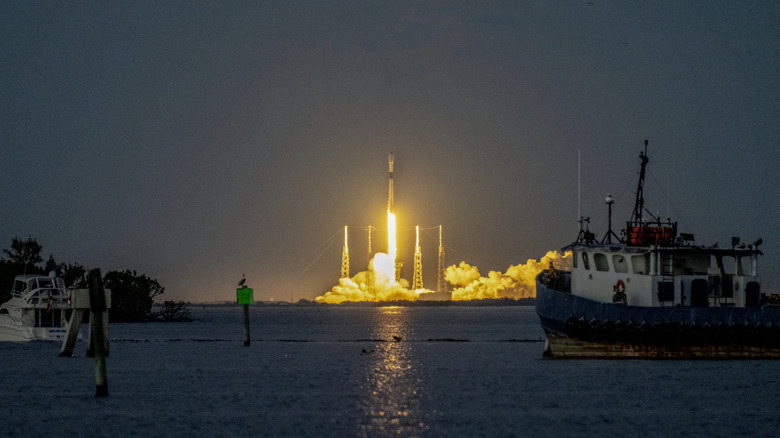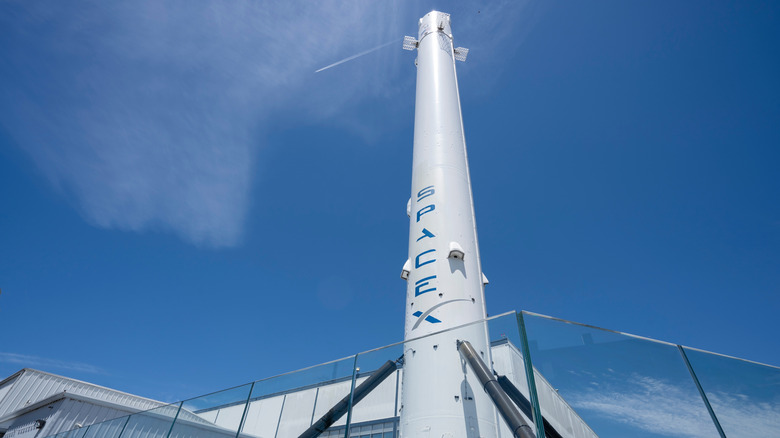SpaceX Just Shot Dozens Of New Starlink Satellites Into Space
Although not regarded as one of the most important SpaceX missions to date, the last deployment of Starlink satellites for the month of September proved to be a successful continuation of the space transportation company's prolific launches in modern aerospace. On Sept. 28, 2025, a Falcon 9 rocket lifted off from Vandenberg Space Force Base in California to deliver 28 broadband internet satellites into low Earth orbit as part of SpaceX's ever-expanding megaconstellation satellite project. The deployment was completed just over an hour after liftoff.
While the launch, called the Starlink 11-20 mission, concluded the 16 successful orbital launches for September, it marked SpaceX's 88th Starlink-supporting mission this year. Such missions are necessary for the continuous development of Starlink, dubbed the next frontier in internet technology. Each satellite plays a role in the service's global internet coverage. The addition of new satellites is needed to handle the growing demand for Starlink's internet service. However, it's worth noting that the company now deploys fewer satellites than in previous missions.
Was this SpaceX's biggest satellite deployment mission yet?
With 28 satellites deployed, the Starlink 11-20 mission may seem like a significant milestone, but it is no means the largest satellite deployment ever by the company. The honor belongs to Transporter-1, a landmark launch that happened on Jan. 24, 2021. During that historic mission, a Falcon 9 rocket lifted off from Cape Canaveral, Florida, carrying a total of 143 satellites into orbit. However, while this one is the more impressive feat, it is worth noting that Transporter-1 was not a Starlink-exclusive mission. It carried a large number of satellites from commercial and government operators as part of SpaceX's RideShare Program, which is basically a cosmic carpool.
Looking at Starlink-only launches, the September mission is also not the biggest since earlier launches carried heavier payloads. In fact, the first Starlink mission brought 60 satellites into space when the program began in May 2019. Today, the quantity per launch is smaller, averaging in the 20s, but each satellite now carries four times the data capacity of earlier models, thanks to the upgraded satellite design. Older-generation satellites weighed 537 lbs (260 kg) each, while the newer models weigh approximately 1,760 lbs (800 kg). Even with the reduced payload, the number of Starlink satellites orbiting outside the planet is already massive. And there's a harsh truth about the thousands of satellites Elon Musk's firm is launching into orbit.
Growing concerns over Elon Musk's expanding satellite megaconstellation
While many high-speed internet consumers, especially those in remote areas, applaud SpaceX's rapid progress, others are sounding the alarm over the possible long-term consequences of deploying such a large number of metal objects into Earth's orbit. As of Sept. 25, 2025, there are 8,475 Starlink satellites traversing around the planet, and of those, 8,460 are active, according to astronomer Jonathan McDowell, who keeps track of space objects. In case you also want to track Starlink satellites, sites like the SpaceX Starlink Satellites Tracker and astronomy software Stellarium and SkySafari will come in handy.
Given the size of Musk's megaconstellation of satellites, scientists fear that the bright reflections from the space objects could already be interfering with telescope observations from Earth, blurring long-exposure images, as well as complicating the study of distant galaxies and possible exoplanets. Equally concerning is the risk of space missions potentially colliding with active and deorbiting units. There is also the issue with decommissioned satellites reentering the atmosphere, as they can introduce large quantities of vaporized metals in the process and contribute to the already worsening global pollution.


